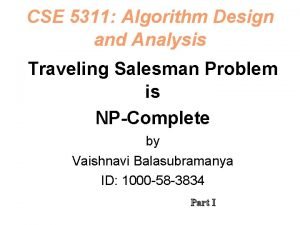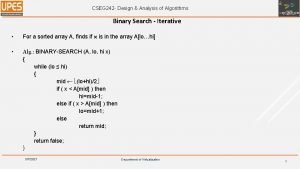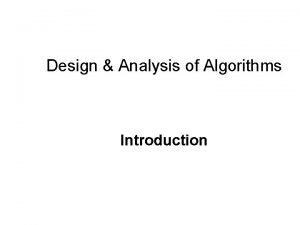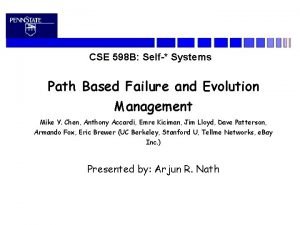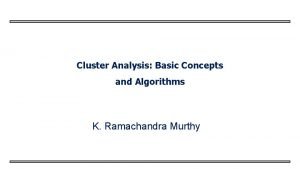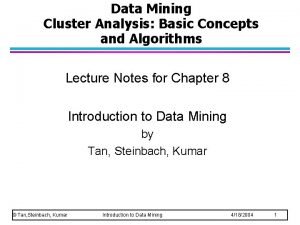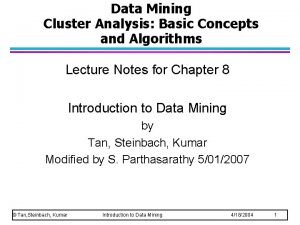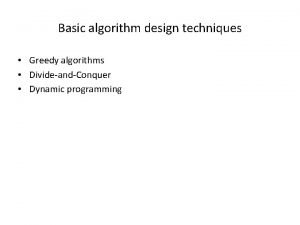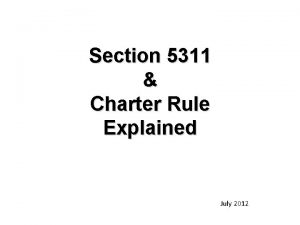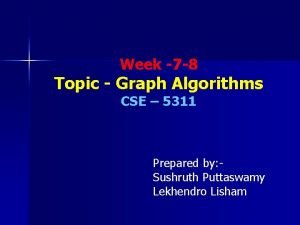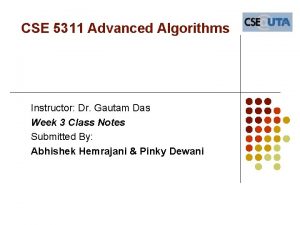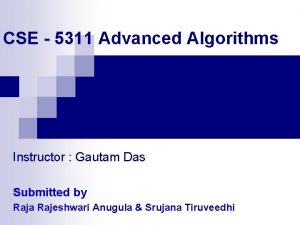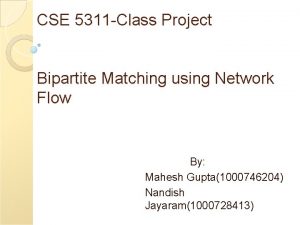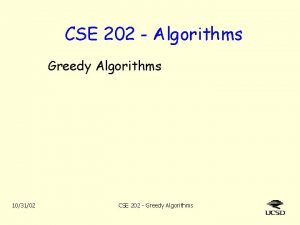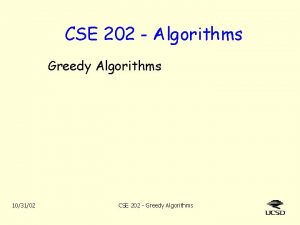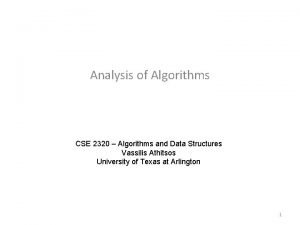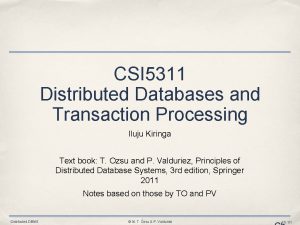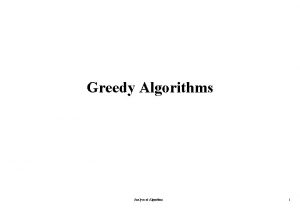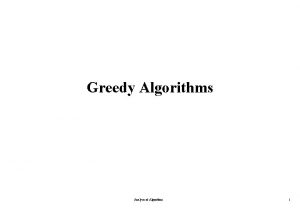CSE 5311 DESIGN AND ANALYSIS OF ALGORITHMS Definitions



![Sample Algorithm FINDING LARGEST NUMBER INPUT: unsorted array ‘A[n]’of n numbers OUTPUT: largest number Sample Algorithm FINDING LARGEST NUMBER INPUT: unsorted array ‘A[n]’of n numbers OUTPUT: largest number](https://slidetodoc.com/presentation_image_h2/7b48d7ec41a5218554b85489d30e8b37/image-4.jpg)















- Slides: 19

CSE 5311 DESIGN AND ANALYSIS OF ALGORITHMS

Definitions of Algorithm n n n A mathematical relation between an observed quantity and a variable used in a step-by-step mathematical process to calculate a quantity Algorithm is any well defined computational procedure that takes some value or set of values as input and produces some value or set of values as output A procedure for solving a mathematical problem in a finite number of steps that frequently involves repetition of an operation; broadly : a step-by-step procedure for solving a problem or accomplishing some end (Webster’s Dictionary)

Analysis of Algorithms Involves evaluating the following parameters n Memory – Unit generalized as “WORDS” n Computer time – Unit generalized as “CYCLES” n Correctness – Producing the desired output
![Sample Algorithm FINDING LARGEST NUMBER INPUT unsorted array Anof n numbers OUTPUT largest number Sample Algorithm FINDING LARGEST NUMBER INPUT: unsorted array ‘A[n]’of n numbers OUTPUT: largest number](https://slidetodoc.com/presentation_image_h2/7b48d7ec41a5218554b85489d30e8b37/image-4.jpg)
Sample Algorithm FINDING LARGEST NUMBER INPUT: unsorted array ‘A[n]’of n numbers OUTPUT: largest number -----------------------------1 large ← A[j] 2 for j ← 2 to length[A] 3 if large < A[j] 4 large ← A[j] 5 end

Space and Time Analysis (Largest Number Scan Algorithm) SPACE S(n): One “word” is required to run the algorithm (step 1…to store variable ‘large’) TIME T(n): n-1 comparisons are required to find the largest (every comparison takes one cycle) *Aim is to reduce both T(n) and S(n)

ASYMPTOTICS Used to formalize that an algorithm has running time or storage requirements that are ``never more than, '' ``always greater than, '' or ``exactly'' some amount

ASYMPTOTICS NOTATIONS O-notation (Big Oh) n n Asymptotic Upper Bound For a given function g(n), we denote O(g(n)) as the set of functions: O(g(n)) = { f(n)| there exists positive constants c and n 0 such that 0 ≤ f(n) ≤ c g(n) for all n ≥ n 0 }

ASYMPTOTICS NOTATIONS Θ-notation Asymptotic tight bound n Θ (g(n)) represents a set of functions such that: Θ (g(n)) = {f(n): there exist positive constants c 1, c 2, and n 0 such that 0 ≤ c 1 g(n) ≤ f(n) ≤ c 2 g(n) for all n≥ n 0} n

ASYMPTOTICS NOTATIONS Ω-notation Asymptotic lower bound n Ω (g(n)) represents a set of functions such that: Ω(g(n)) = {f(n): there exist positive constants c and n 0 such that 0 ≤ c g(n) ≤ f(n) for all n≥ n 0} n

n O-notation --------- Less than equal to (“≤”) n Θ-notation --------- Equal to (“=“) n Ω-notation --------- Greater than equal to (“≥”)

Mappings for n 2 Ω (n 2 ) Θ(n 2) O(n 2 )

Bounds of a Function Cntd…

Cntd… c 1 , c 2 & n 0 -> constants n T(n) exists between c 1 n & c 2 n n Below n 0 we do not plot T(n) n T(n) becomes significant only above n 0 n

Common plots of O( ) O(2 n) O(n 3 ) O(n 2) O(nlogn) O(√n) O(logn) O(1)

Examples of algorithms for sorting techniques and their complexities Insertion sort : O(n 2) n Selection sort : O(n 2) n Quick sort : O(n logn) n Merge sort : O(n logn) n

RECURRENCE RELATIONS A Recurrence is an equation or inequality that describes a function in terms of its value on smaller inputs n Special techniques are required to analyze the space and time required n

RECURRENCE RELATIONS EXAMPLE 1: QUICK SORT T(n)= 2 T(n/2) + O(n) T(1)= O(1) n In the above case the presence of function of T on both sides of the equation signifies the presence of recurrence relation n (SUBSTITUTION MEATHOD used) The equations are simplified to produce the final result: ……cntd

Cntd…. T(n) = 2 T(n/2) + O(n) = 2(2(n/22) + (n/2)) + n = 22 T(n/22) + n = 22 (T(n/23)+ (n/22)) + n = 23 T(n/23) + n + n = n log n

Cntd… EXAMPLE 2: BINARY SEARCH T(n)=O(1) + T(n/2) T(1)=1 Above is another example of recurrence relation and the way to solve it is by Substitution. T(n)=T(n/2) +1 = T(n/22)+1+1 = T(n/23)+1+1+1 = logn T(n)= O(logn)
 Cse 5311
Cse 5311 0 and 1 code alphabet
0 and 1 code alphabet Design and analysis of algorithms syllabus
Design and analysis of algorithms syllabus Introduction of design and analysis of algorithms
Introduction of design and analysis of algorithms Binary search in design and analysis of algorithms
Binary search in design and analysis of algorithms Introduction to the design and analysis of algorithms
Introduction to the design and analysis of algorithms Design and analysis of algorithms
Design and analysis of algorithms Design and analysis of algorithms
Design and analysis of algorithms Design and analysis of algorithms
Design and analysis of algorithms Cse 598 advanced software analysis and design
Cse 598 advanced software analysis and design Association analysis: basic concepts and algorithms
Association analysis: basic concepts and algorithms Cluster analysis: basic concepts and algorithms
Cluster analysis: basic concepts and algorithms Probabilistic analysis and randomized algorithms
Probabilistic analysis and randomized algorithms Cluster analysis basic concepts and algorithms
Cluster analysis basic concepts and algorithms Cluster analysis basic concepts and algorithms
Cluster analysis basic concepts and algorithms Exercise 24
Exercise 24 Cluster analysis basic concepts and algorithms
Cluster analysis basic concepts and algorithms Output design
Output design Design techniques of algorithms
Design techniques of algorithms Algorithms for visual design
Algorithms for visual design
